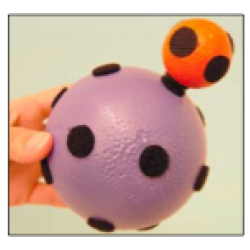Source Institutions
Source Institutions
Add to list Go to activity
Activity link broken? See if it's at the internet archive

This activity demonstrates the specificity of viral vectors for target cells in gene therapy delivery methods using two approaches: 1) STYROFOAM® models demonstrate viral ligand binding to receptor proteins on the surface of target cells; 2) Learners use paper models of viruses and cells to find the appropriate match between viral ligands and cell receptors.
- 10 to 30 minutes
- 10 to 30 minutes
- $10 - $20 per group of students
- Ages 11 - 18
- Activity, Lesson/Lesson Plan, Model
- English
Quick Guide
Materials List (per group of students)
- 2 - 4-inch smooth STYROFOAM® balls
- 2 - 1.5-inch smooth STYROFOAM® balls
- Snap tape, 1/4 to 1/2 yard (can be obtained at any fabric store)
- VELCRO® hook and loop fasteners, one package adhesive-backed circles (can be obtained at any fabric store)
- Hot glue gun
- Spray paint (optional)
- Pages S1 to S6 - enough copies to give one Virus or Cell cut-out to each learner
Subjects
-
Life Sciences
-
Cells
- Cell Structure and Function
-
Diversity of Life
- Viruses and Bacteria
-
Heredity and Genetics
- DNA Structure and Function
- Genetic Engineering
-
Human Body
- Health and Nutrition
- Medicine
-
Cells
-
Physical Sciences
-
Chemistry
- Chemistry of Life
-
Chemistry
Informal Categories
- Model Building
Audience
To use this activity, learners need to:
- see
- read
- touch
Learning styles supported:
- Involves hands-on or lab activities
Other
Components that are part of this resource:
Includes alignment to state and/or national standards:
This resource is part of:
Access Rights:
- Free access
By:
- Carillo, Alayne ; Turner, Vicki ; Stark, Louisa ; Malone, Molly ; Limson, Mel ; Starr, Harmony
Source Collection
- Teach.Genetics
Rights:
- All rights reserved, University of Utah, 2002
Funding Source:
- Science Education Partnership Award (SEPA) from the National Center for Research Resources, a component of the National Institutes of Health, Department of Health and Human Services, 1 R25 RR16291-01
